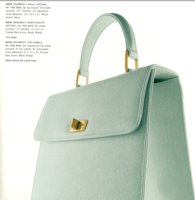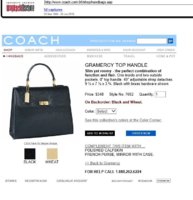PAGE 2
THE CENTERED C RULE or THE C'S ARE PERFECTLY STRAIGHT RULE
MOSTLY true, with plenty of exceptions. The center seam or a line down the front of a bag with Signature or Op Art C's should usually divide it into 2 halves that are mirror images of each other.
But:
Sometimes the back isn't correctly centered like style 10483 and the front is mistaken for the back.
Some C patterns on styles like some older Scribble Hobos don't follow the rule.
Some Messenger Bags like # 70077, Heritage Stripe Crossbody Messenger have NOTHING centered.
Most Signature Tartan Plaid bags and accessories made for the outlets in 2010 and 2011 don't follow the Rule, like #15229, 15485 and a bunch more.
Some older bags with Shearling Lamb trim from 2005 like 8K47, 8K48, have the C's set at a 45-degree angle, and so do some of the coated Canvas items sold at the outlets in and around 2011.
Many fabric patterns don't or won't follow the Rule, like almost all the Scarf Pattern items, and ALL the Optic Signature items where you couldn't line them up if you tried because the pattern is designed to make the C's look randomly scattered all over the fabric.
Many newer patterns and embossed leathers from 2011 don't seem to follow any sort of alignment rules either.
If you're not sure what these styles and patterns look like, Search for them on Ebay. Ask at the ATC thread if you're not sure.
THE C'S SHOULD MATCH AT THE SEAMS RULE
They often do on bags with straight up & down sides, but it's almost impossible to match them along curved seams. This "rule" should be ignored, just like...
THE C'S SHOULDN'T BE CUT THROUGH ALONG THE SEAMS
I don't know who came up with this one but they must have gotten Coach confused with Louis Vuitton. It's IMPOSSIBLE to cut and sew a regular Signature or Mini-Sig pattern without cutting through Cs. Try it sometime.
THE C'S OUTSIDE - NO C'S INSIDE RULE
MOSTLY TRUE, with exceptions. When the outside fabric is predominantly Signature Cs of any kind or the Coach name or logo, the inside of the bag should NEVER have Signature C, Op Art or any other name or logo lining. A lot of counterfeiters do this and it's a huge red flag. To make it worse, they use some amazingly bad fabrics and patterns for their fake linings, like shiny mini-C pattern acetate in many older bags, and a cheap printed C or Op Art C pattern in newer ones.
THE EXCEPTIONS - very few when the outside Cs take up more than half the bag's fabric surface. The Wave Gallery bags from the mid-2000s #s 1439, 1441 and a few others are among the rare exceptions. If there are C's or logos outside and inside, don't bid. (BTW, this does NOT apply to wallets which sometimes have Cs in & out).
The more the maker seems to be trying to convince you that it's a Coach, the more cautious you should be.
THE PATCHWORK FRONT AND BACK RULE
True, all Patchwork bags & accessories should have the same patchwork on both front and back. If one side is Signature C fabric, it's counterfeit. Ask here for authentication.
THE "COACHES ARE ALWAYS PERFECT" RULE
Not in my lifetime or in yours. Perfection costs money, how much are you willing to spend? This AIN'T Louis Vuitton, folks.
Coach plant employees make plenty of mistakes, especially in new plants, some of the stitching at early Chinese plants was more like waves than lines. Older bags had plenty of mistakes too, especially in how the creeds and serial numbers were stamped. Sometimes even the wrong style or serial number was stamped, but any bag with that kind of mistake needs to be authenticated here at tPF before buying or selling. That's a good reason for sellers to show a full set of photos of their items, inside and out including the creed. NO ONE SHOULD EVER BUY ANY COACH ITEM, NEW OR USED, WITHOUT SEEING A FULL SET OF PHOTOS INCLUDING A READABLE CREED AND SERIAL NUMBER IF PRESENT.
THE "COACHES ARE ONLY MADE IN..." RULES
Depends. Coach bags have been made in the USA, Italy, Costa Rica, Dominican Republic, Mexico, Hungary, Turkey, Thailand, China, India, and Vietnam. Coach is also making bags in the Philippines, Myanmar, and other countries where they can find cheap labor, and they have made accessories like wallets in even more places such as France, Spain and others. Only the Asian plants except for Thailand are still active at this time (2018). Production moved almost completely to China starting in 2000 although a few handbags and some travel and business items had been made there for several years already, and all Signature C fabric bags are only made in China and the other Asian plants and have only been made since 2000. Any Signature C bag with a year code from before 2000, or with a plant code or place of origin that indicates it was made in the US, is counterfeit.
GO TO PAGE 3
THE CENTERED C RULE or THE C'S ARE PERFECTLY STRAIGHT RULE
MOSTLY true, with plenty of exceptions. The center seam or a line down the front of a bag with Signature or Op Art C's should usually divide it into 2 halves that are mirror images of each other.
But:
Sometimes the back isn't correctly centered like style 10483 and the front is mistaken for the back.
Some C patterns on styles like some older Scribble Hobos don't follow the rule.
Some Messenger Bags like # 70077, Heritage Stripe Crossbody Messenger have NOTHING centered.
Most Signature Tartan Plaid bags and accessories made for the outlets in 2010 and 2011 don't follow the Rule, like #15229, 15485 and a bunch more.
Some older bags with Shearling Lamb trim from 2005 like 8K47, 8K48, have the C's set at a 45-degree angle, and so do some of the coated Canvas items sold at the outlets in and around 2011.
Many fabric patterns don't or won't follow the Rule, like almost all the Scarf Pattern items, and ALL the Optic Signature items where you couldn't line them up if you tried because the pattern is designed to make the C's look randomly scattered all over the fabric.
Many newer patterns and embossed leathers from 2011 don't seem to follow any sort of alignment rules either.
If you're not sure what these styles and patterns look like, Search for them on Ebay. Ask at the ATC thread if you're not sure.
THE C'S SHOULD MATCH AT THE SEAMS RULE
They often do on bags with straight up & down sides, but it's almost impossible to match them along curved seams. This "rule" should be ignored, just like...
THE C'S SHOULDN'T BE CUT THROUGH ALONG THE SEAMS
I don't know who came up with this one but they must have gotten Coach confused with Louis Vuitton. It's IMPOSSIBLE to cut and sew a regular Signature or Mini-Sig pattern without cutting through Cs. Try it sometime.
THE C'S OUTSIDE - NO C'S INSIDE RULE
MOSTLY TRUE, with exceptions. When the outside fabric is predominantly Signature Cs of any kind or the Coach name or logo, the inside of the bag should NEVER have Signature C, Op Art or any other name or logo lining. A lot of counterfeiters do this and it's a huge red flag. To make it worse, they use some amazingly bad fabrics and patterns for their fake linings, like shiny mini-C pattern acetate in many older bags, and a cheap printed C or Op Art C pattern in newer ones.
THE EXCEPTIONS - very few when the outside Cs take up more than half the bag's fabric surface. The Wave Gallery bags from the mid-2000s #s 1439, 1441 and a few others are among the rare exceptions. If there are C's or logos outside and inside, don't bid. (BTW, this does NOT apply to wallets which sometimes have Cs in & out).
The more the maker seems to be trying to convince you that it's a Coach, the more cautious you should be.
THE PATCHWORK FRONT AND BACK RULE
True, all Patchwork bags & accessories should have the same patchwork on both front and back. If one side is Signature C fabric, it's counterfeit. Ask here for authentication.
THE "COACHES ARE ALWAYS PERFECT" RULE
Not in my lifetime or in yours. Perfection costs money, how much are you willing to spend? This AIN'T Louis Vuitton, folks.
Coach plant employees make plenty of mistakes, especially in new plants, some of the stitching at early Chinese plants was more like waves than lines. Older bags had plenty of mistakes too, especially in how the creeds and serial numbers were stamped. Sometimes even the wrong style or serial number was stamped, but any bag with that kind of mistake needs to be authenticated here at tPF before buying or selling. That's a good reason for sellers to show a full set of photos of their items, inside and out including the creed. NO ONE SHOULD EVER BUY ANY COACH ITEM, NEW OR USED, WITHOUT SEEING A FULL SET OF PHOTOS INCLUDING A READABLE CREED AND SERIAL NUMBER IF PRESENT.
THE "COACHES ARE ONLY MADE IN..." RULES
Depends. Coach bags have been made in the USA, Italy, Costa Rica, Dominican Republic, Mexico, Hungary, Turkey, Thailand, China, India, and Vietnam. Coach is also making bags in the Philippines, Myanmar, and other countries where they can find cheap labor, and they have made accessories like wallets in even more places such as France, Spain and others. Only the Asian plants except for Thailand are still active at this time (2018). Production moved almost completely to China starting in 2000 although a few handbags and some travel and business items had been made there for several years already, and all Signature C fabric bags are only made in China and the other Asian plants and have only been made since 2000. Any Signature C bag with a year code from before 2000, or with a plant code or place of origin that indicates it was made in the US, is counterfeit.
GO TO PAGE 3





